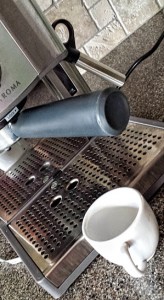Those of you who know me, know I love my coffee. You’ll also know that I’ve been dreaming of getting up on a Saturday morning and being able to brew my own cappuccino without exposing myself to the Canadian polar vortex to get it.
What was holding me back, however, was fear and uncertainty. I was afraid of buying the wrong machine, afraid I wouldn’t figure it out and also uncertain if my efforts would really ever result in a good enough cup or ROI.
Spoiler alert – I did actually make my very first cappuccino this morning and it’s sitting next to me as I write this. Because I know you’re very curious to find out how I overcame my espresso learning and performance barriers, I’ve shared my experience below.
My Pre-Work
Social Learning: Being not quite sure if I was up to the challenge, I called my brother, who is a coffee aficionado, and asked about the espresso machine he uses and the level of difficulty. I also asked what tips he had based on his experience making his own cappuccinos. He assured me that the model he was recommending to me was for beginners but still a good machine and that it wouldn’t take long for me to get a good cup. If you haven’t noticed, time to proficiency was very important to me. If it took too long, I would lose interest and get back into my car to the coffee bar.
Self-Directed: After chatting with my brother, I felt like I was ready for the next steps so I went on espresso machine review sites and followed it up by watching a few short YouTube videos on making espresso and cappuccino. I then spent a little time researching the tools and equipment that I’d need, like a coffee grinder, thermometer for the steamed milk, and, last but not least, the beans, which are the most important component of any great coffee.
Learning at the Point of Need: Making my First Cappuccino
With espresso machine and beans purchased, I was ready to brew.
Self Directed Learning: I unpacked the espresso machine and used the manual to identify all the machine parts and their purpose. I also read the instructions that came with the machine on how to make a cappuccino.
Social Learning: While I felt knowledge ready – I still had a few questions. While I knew that I could do another dozen searches and read another twenty blog posts, what I really wanted was the benefit of personal experience so I texted my brother one last time. I told him I was ready to go and asked him for any last minute tips that he could provide. He reiterated again that I needed super fresh beans, that the grounds needed to be well packed, and that the milk needed to really cold before steaming. He also mentioned that over steamed milk tastes bitter and that if I didn’t have a thermometer that I’d know things were going downhill if I heard some loud screeching (very good tip).
With these final pieces of advice and the 4 page manual next to me (more of a job aid with pictures), I proceeded to make my very first cappuccino. I have to admit, the first one resulted in rather cool steamed milk and a so-so espresso, but once I figured out that the steamer wand needed to be all the way down in the milk to really heat up, the second and third attempts were much better.
Reflecting on my cappuccino making experience this morning reminded me of how my clients and their learners feel when facing change and new learning at work.
It doesn’t matter if an employee needs to learn how to use the new scanner, balance a budget, or lead a team through a crisis, there is always some level of uncertainty/doubt and/or fear involved.
By reflecting on my simple example with the espresso machine, it becomes clear just how important social learning and the availability of the right resources at the time of need are to learning and performance. In my case, it was the blend of the social and the great resources that removed my barriers (fear of failure and unknown) to success and kept me trying, even when the first brew wasn’t barista quality.
